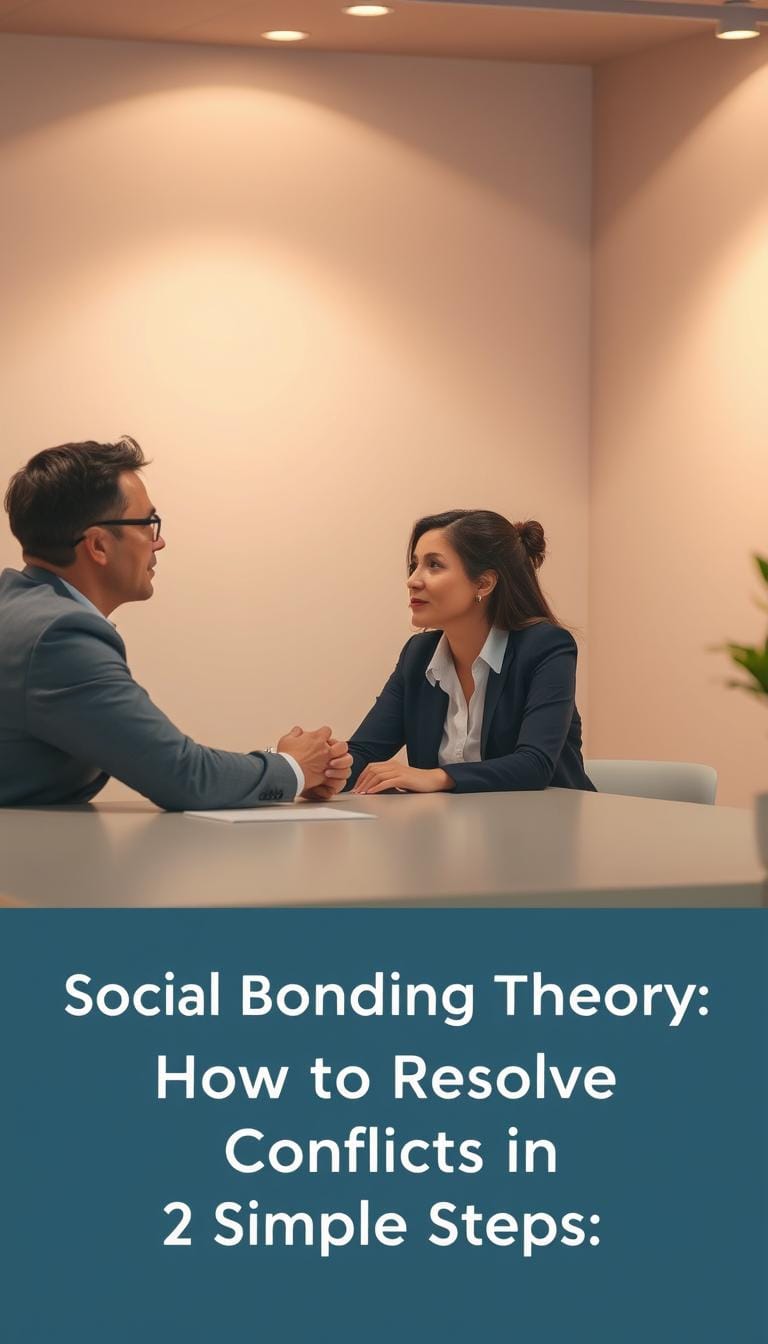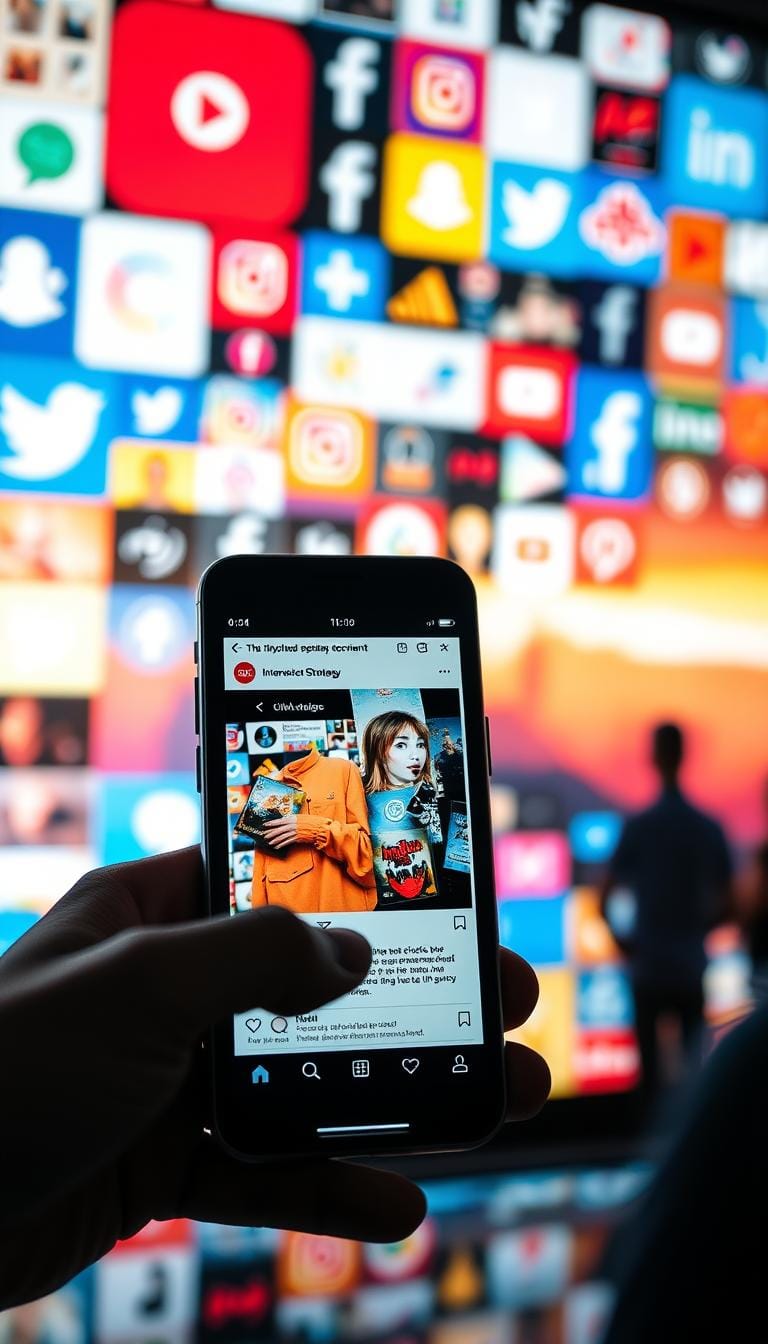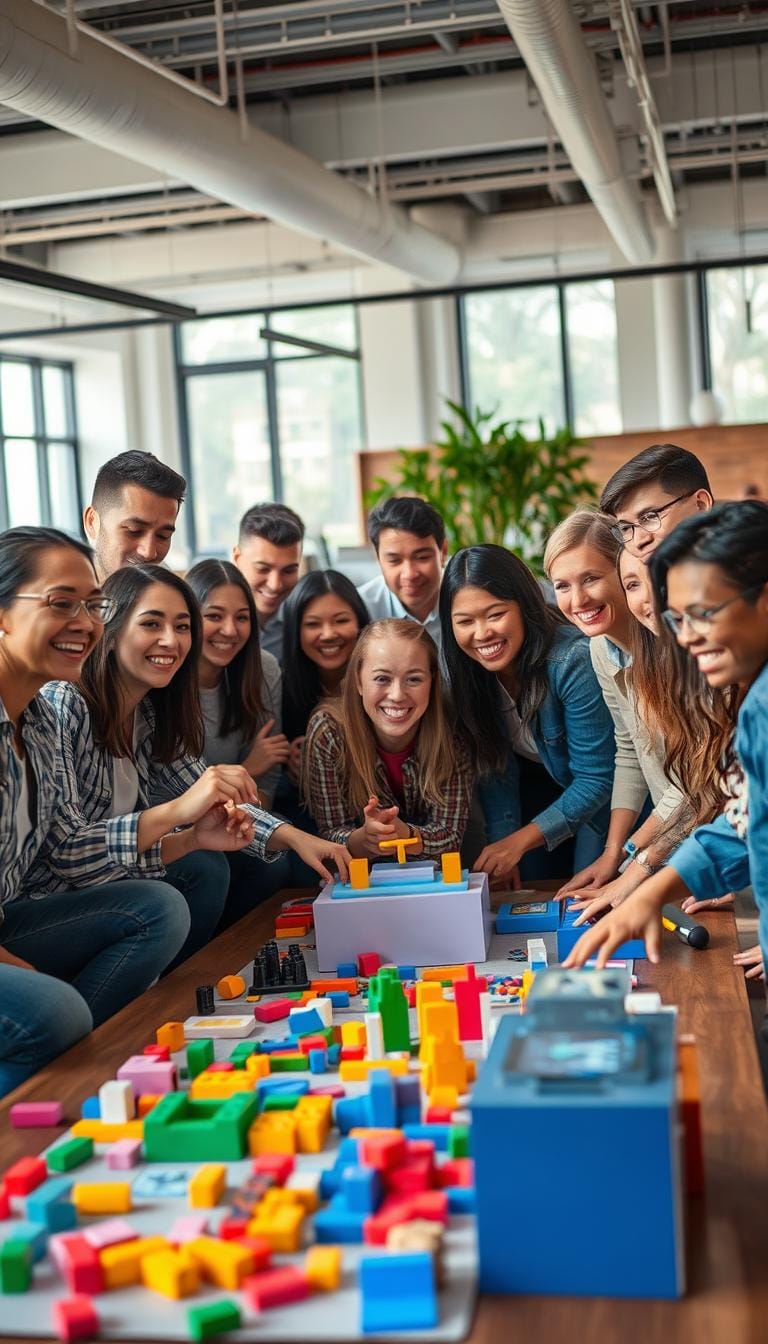Social Bonding Theory: How to Resolve Conflicts in 2 Simple Steps
Table of Contents
Keeping our interpersonal relationships healthy is key. Understanding the social bonding theory helps us deal with disputes better. It also makes our bonds stronger with others.
The social bonding theory says our relationship strength depends on how well we solve conflicts. By using two easy steps from this theory, we can get better at conflict resolution. This makes our relationships more solid.

In this article, I’ll share these two steps. I’ll also explain how they help in relationship formation and solving conflicts. By the end, you’ll know how to use the social bonding theory to better your relationships.
The Power of Human Connection
The power of human connection is huge, affecting our mental health and happiness. Humans are naturally social, and our lives get better with the relationships we make and keep.
Why We Need Social Bonds
Social bonds give us a feeling of belongingness and support. They are key for our emotional and mental health. Through talking and sharing, we build trust, share experiences, and grow empathy. Some main benefits of social bonds are:
- Emotional support during tough times
- A sense of identity and belonging
- Chances for personal growth and development
The Cost of Unresolved Conflicts
Unresolved conflicts harm our social connections. When we don’t fix conflicts, we feel isolated and resentful. The cost of not solving conflicts includes:
- Strained relationships
- Higher stress levels
- A weaker sense of community and belonging
By seeing how important human connection is and fixing conflicts, we can make our social bonds stronger. This improves our overall well-being.

What Is Social Bonding Theory?
The Social Bonding Theory helps us understand how our connections with others grow or fade. It ties closely to attachment theory. This theory says our early relationships shape our attachment styles and bonding processes for life.

Origins and Development
Social Bonding Theory comes from sociology and psychology. It grew from early sociologists who looked into how groups form and stick together. Now, it combines insights from psychology to grasp bonding processes and their effects on us and our groups.
Key Principles and Concepts
The theory focuses on emotional ties, shared moments, and mutual support in building strong bonds. It also points out the importance of commitment and involvement in relationships. Knowing these, we can handle conflicts better and make our bonds stronger.
The Four Elements of Social Bonds
Social Bonding Theory says there are four main parts to strong social ties. These parts are key to knowing how to create and keep good interpersonal relationships.
Attachment: Emotional Connections
Attachment is about the emotional ties we make with others. It’s feeling safe and connected, which is important for our mental health. A strong attachment grows from shared moments and support, making our social interaction better.
Commitment: Investment in Relationships
Commitment means putting effort into our relationships. It’s about being loyal to those we love and facing problems together. This effort makes our social relationships stronger and gives us a sense of belonging.
Involvement: Shared Activities and Time
Involvement is about spending good time together and doing things as a team. This time creates shared memories and experiences, making our bonds stronger. Regular social interaction through involvement is essential for healthy relationships.
Belief: Common Values and Norms
Belief is about the shared values and norms in a relationship or community. Having common beliefs brings unity and cooperation. It makes it easier to handle conflicts and challenges in interpersonal relationships.
By focusing on and caring for these four elements, we can greatly improve our social bonds. This leads to more rewarding social relationships.
How Conflicts Damage Our Social Connections
Unresolved conflicts can really hurt our social connections, affecting our happiness. When we face conflict, it can make our relationships worse. This leads to feelings of being alone and disconnected.
Psychological Impact of Conflict
Conflicts can deeply affect our minds, causing more stress, anxiety, and depression. The emotional pain from unresolved conflicts is big. It hurts not just the person but also the relationship.
The mind can react in many ways, like feeling less worthy, being more emotional, and losing empathy. Knowing these effects helps us find better ways to solve conflicts.
Breaking Points in Relationships
Every relationship has a breaking point. If conflicts go past this point, fixing the relationship can be hard. It’s important to know when this happens to stop relationships from falling apart.
Seeing signs like constant anger, avoiding each other, or being aggressive is key. By noticing these signs early, we can start fixing the problems and mend our relationships.
Good conflict resolution strategies are vital for keeping strong social connections and healthy interpersonal relationships. Understanding the mind’s reaction to conflicts and knowing when to act helps us deal with relationship challenges better.
The Neuroscience Behind Social Bonding
Learning about the science of social bonding can change how we handle conflicts and relationships. Our brain chemistry and stress responses are key to understanding human connection.
When we connect with others, our brain sends out special chemicals. Oxytocin, known as the “love hormone,” helps us feel trust and calm. Dopamine and endorphins make us feel good about being social.
Brain Chemistry During Connection
Creating social bonds is a complex process. It involves many chemicals and hormones working together. When we have positive interactions, oxytocin and dopamine make us feel connected and happy.
| Neurotransmitter/Hormone | Function in Social Bonding |
|---|---|
| Oxytocin | Promotes trust and attachment |
| Dopamine | Reinforces pleasure and reward |
| Endorphins | Enhances feelings of well-being |
Stress Responses During Conflict
Conflicts, on the other hand, make our brain release stress chemicals like cortisol and adrenaline. These get us ready to fight or run away, making conflicts worse. Knowing this can help us deal with conflicts better.
Understanding the science behind social bonding and conflict helps us find better ways to solve problems and strengthen relationships. This knowledge lets us face conflicts with a deeper understanding of the biological forces involved.
Step 1: Recognize and Validate Emotional Needs
The first step to fix strained interpersonal relationships is to understand and accept the emotional needs of those involved. Conflicts often come from unmet emotional needs, making us feel alone and disconnected. By acknowledging these needs, we start to rebuild emotional connections and create a sense of belongingness in our social relationships.
Identifying Core Emotional Triggers
To really get what emotional needs are, we need to find out what makes us react in conflicts. These triggers usually come from past experiences, our values, and how much we care about the relationship. Knowing what triggers us helps us handle conflicts better and find solutions.
The Validation Process
Validation is key in fixing conflicts. It means we acknowledge the other person’s feelings and show we care about their experience. It’s not about agreeing with them, but about understanding their emotions. This makes our emotional connections stronger and helps us talk better.
Active Listening Techniques
Listening well is a big part of validation. It means we focus on what the other person is saying, get their point of view, and respond thoughtfully. We do this by keeping eye contact, nodding, and repeating back what they said to make sure we get it right.
Empathetic Response Strategies
Being empathetic is important in validating emotional needs. It means we acknowledge their feelings and show we understand through words and actions. Empathetic responses make a safe space where both sides feel heard and understood, helping us solve conflicts better.
Using these strategies helps us make our interpersonal relationships stronger and more resilient. Understanding and validating emotional needs is a key step in fixing conflicts and improving our connections and belongingness with others.
Step 2: Rebuild Trust Through Shared Goals
Rebuilding trust is key in solving conflicts. It happens when both sides work towards the same goal. This creates unity and cooperation.
Finding Common Ground
Finding common ground is the first step to rebuild trust. It means active listening and empathy to understand each other. This way, we find shared interests hidden by the conflict.
- Practice active listening to understand the other party’s perspective.
- Identify common goals that align with both parties’ interests.
- Use these shared goals as a foundation for rebuilding trust.
Creating Collaborative Solutions
After finding common ground, we work on solutions together. This means finding outcomes that benefit both sides. Negotiation frameworks help in this process by providing a structured way to agree.
Negotiation Frameworks
Negotiation frameworks guide the discussion to a productive outcome. They help set clear goals, criteria for success, and explore options that please both sides.
Compromise vs. Integration
There are two main ways to find a solution: compromise and integration. Compromise finds a middle ground. Integration creates a new solution that meets both needs.
By focusing on shared goals and working together, we can rebuild trust. This strengthens our relationships and helps us solve conflicts better.
Case Studies: Social Bonding Theory in Action
The Social Bonding Theory works wonders in real-life scenarios. We see its power in different situations. It helps fix conflicts and makes relationships stronger.
Resolving Family Conflicts
A family on the edge of breaking up found a way to come together. They used the Social Bonding Theory. They worked on rebuilding emotional connections and commitment. This helped them heal.
Workplace Relationship Repair
At work, the theory helped colleagues who were not getting along. They found common goals and worked together. This built trust and bettered their work relationship.
Rebuilding Friendships After Betrayal
A friendship hit hard times after a betrayal. But, they applied the Social Bonding Theory. They worked through their problems and reestablished a strong bond.
These stories show how the Social Bonding Theory can help in many ways. It’s all about:
- Understanding the value of emotional connections
- Building commitment and involvement
- Sharing common values and goals
By using the Social Bonding Theory, we can handle tough relationships better. It leads to stronger, more lasting bonds.
Common Obstacles to Effective Bonding
Forming and keeping strong relationships is hard. Many challenges can get in the way. It’s important to know these obstacles to find ways to overcome them.
Defense mechanisms are a big challenge. These are psychological ways people avoid getting close. For example, some might get too defensive or push away when they feel vulnerable.
Defense Mechanisms
Defense mechanisms like denial and rationalization can block bonding. Knowing about these can help make bonding easier. It’s about creating a space where people feel safe to open up.
Communication Barriers
Good communication is key for any strong bond. But, misunderstandings and cultural differences can get in the way. Learning to communicate better is a big step towards overcoming these issues.
| Barrier | Description | Strategy to Overcome |
|---|---|---|
| Misunderstandings | Incorrect interpretation of messages | Clarify and confirm understanding |
| Lack of Active Listening | Not fully engaging with the speaker | Practice active listening techniques |
| Cultural Differences | Differences in communication styles across cultures | Educate oneself on cultural nuances |
Cultural Differences in Bonding
Culture affects how we bond. Different cultures have their own ways of forming and keeping relationships. Knowing about these differences helps us connect better with people from other cultures.
By facing these common challenges, we can work on building stronger bonds. It’s about being aware of ourselves, communicating well, and understanding different cultures.
Beyond Conflict: Strengthening Bonds Proactively
Building strong relationships takes daily effort. By focusing on our social connections, we can feel more connected and happy.
Daily Practices for Connection
Doing small things every day can make a big difference in our human connection. Sharing meals, being thankful, or doing things together can bring us closer.
- Spend quality time with loved ones
- Practice active listening
- Show appreciation and gratitude
Rituals That Reinforce Relationships
Creating rituals can make our relationships feel more stable and comforting. It could be as simple as having dinner together weekly or celebrating big moments.
| Ritual | Frequency | Benefit |
|---|---|---|
| Family Dinner | Daily | Strengthens family bonds |
| Weekly Check-in | Weekly | Enhances communication |
| Celebrating milestones | As needed | Reinforces commitment |
When to Seek Professional Help
Knowing when to ask for professional help is key to keeping relationships healthy. Many conflicts can be solved on your own. But, some need more expert support.
Look for signs that DIY efforts aren’t enough. These include feeling resentful, stuck in conflict cycles, and poor communication. If you can’t move forward or things get worse, it’s time to seek help.
Signs That DIY Methods Aren’t Working
Here are some signs you might need professional help:
- Persistent feelings of anger or hurt
- Repeated patterns of conflict with no resolution
- A significant decrease in emotional intimacy
Types of Professional Support Available
Many options are available for conflict resolution. You can try couples therapy, counseling, or mediation. These services offer a safe space to tackle issues and improve communication.
By spotting when DIY methods fail and getting the right help, you can make big strides. This is in line with social bonding theory, helping you resolve conflicts and strengthen relationships.
Conclusion
Exploring Social Bonding Theory shows us how key it is to strengthen our connections. This is vital for building strong relationships.
By recognizing and validating each other’s emotional needs, we can start to mend broken trust. Sharing goals helps us work together better. This approach makes our relationships stronger and helps us solve problems together.
Social Bonding Theory helps us understand the deep connections we make with others. It teaches us the value of caring for our relationships. By using this theory, we can create deeper, more lasting bonds with others.
This theory’s principles can be used in many areas of life. It helps us improve both personal and professional relationships. It leads to better communication and conflict resolution.






